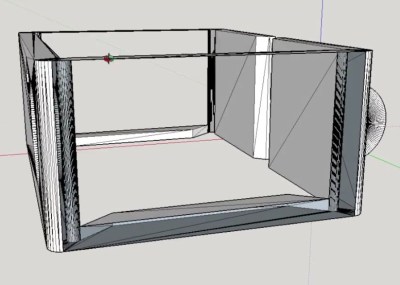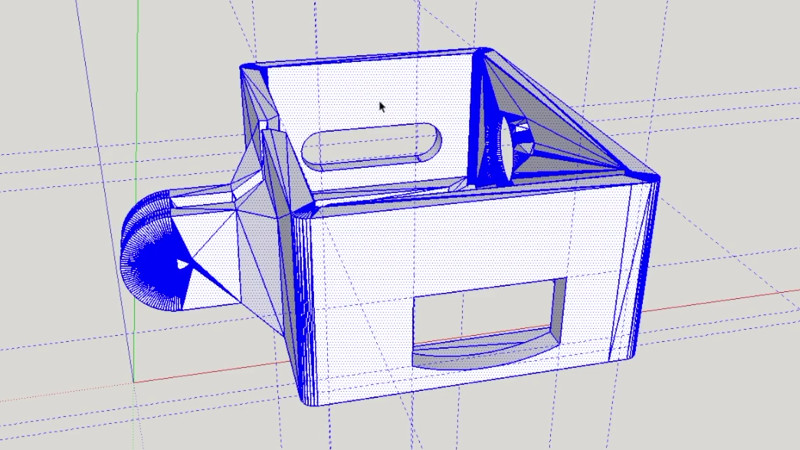[Rob Clarke] needed a mount for his off-brand action camera, but it’s not exactly the kind of thing with a bustling accessory market. To make matters worse, it turns out the camera is so low-key that he couldn’t find a 3D printable mount for it either. Luckily, a check with his calipers confirmed his camera is just about the same size as an old GoPro Hero 3, so all he had to do was modify an existing design to fit his needs.
 As anyone who’s worked with STL files will tell you, they are a pain to modify. An STL is essentially a completed solid model, and not really meant to be fiddled around with. It’s a bit like trying to take an edited image and get back to the layers that were used to create it in Photoshop or GIMP. The final output has been “flattened”, so that granular control is lost.
As anyone who’s worked with STL files will tell you, they are a pain to modify. An STL is essentially a completed solid model, and not really meant to be fiddled around with. It’s a bit like trying to take an edited image and get back to the layers that were used to create it in Photoshop or GIMP. The final output has been “flattened”, so that granular control is lost.
That being said, [Rob] got rather lucky in this case. He found a GoPro mount that was about 90% there, he just needed to adjust the depth and change the positioning of the holes on the side. He loaded the STL into SketchUp, deleted the two sides, and replaced them with new surfaces. This gave him a clean slate to add the appropriate openings for his camera’s USB port and microSD card. To adjust the depth of the mount, he simply stretched the model out on the Z axis.
[Rob] event went ahead and released his modified STLs as a remix of the original case he found on Thingiverse for anyone else that has the same camera. That’s what we love to see.
If you’re interested in learning more about using SketchUp for designing 3D printed parts, check out this excellent guide by our very own [Brian Benchoff].
















Blender also works reasonably well for simple modifications. Use tab key to get to the mesh edit mode, select the vertices you want to move with B, type G to grab them, constrain to selected axis with X, Y or Z key, and type in the numbers for the distance you want to move. Accurate and fast.
Yeah I use blender as well, they have an import option for stls … I have used this a few times as a way to get everything in one place or modify
One nice thing about SketchUp (at least, the pre-cloud versions) is the Ruby-based plug-in system that allows one to do just about any conceivable thing to 3D geometry (with a very easy to learn language/API). For working with STLs, I use a plug-in that can “de-triangulate” divided surfaces by removing edges between parallel faces. I don’t remember where I got it, but I think it’s called “Cleanup” or something to that effect.
Yup it’s CleanUp³. I used it as well when I was using Sketchup. I had some issue installing because of the TT_Lib² dependency. But it worked pretty well once installed.
Actually, I think I use a simpler, standalone one, but I think I’ll check that one out. Thom_Thom makes great plugins.
I’ve learned to hate SketchUp. For the simple reason that it has a tendency to create very flawed models. Faces the wrong way around, duplicate faces, holes. You name it, the problem is there.
Q: “Why is this model not slicing correctly?”
A: “Was it made in SketchUp?”
Q: “Yes, why?”
A: “That’s why you have problems.”
There are plugins that try to fix this. But it shows the core is broken for 3D solid modeling, ductape remains ductape.
(FYI, I’m the original creator of Cura. So I have done my share of support questions)
It seems like the majority of more artistic models (e.g. minis) I find have horrible meshes that are practically unprintable. Crazy overlapping surfaces, non-manifold edges, “flat” surfaces that aren’t actually flat etc. These can be corrected to a certain extent, but I’ve had plenty of models that Meshlab/Meshmixer simply couldn’t fix no matter how much I tweaked.
Most of those models are not designed, they are ripped from games. And thus made to look good with as few polygons as possible. Models for leage-of-legends and world-of-warcraft are most common.
The only real problem is that it was designed to build buildings, not 3D printed parts. The internal unit is the inch, so it’s easy to go outside the precision range of a float when you use actual units at normal scale. The trick is to work on everything at 1000x scale. Thousandths become inches, millimeters become meters. Scale back down when you export for slicing, and everything’s fine.
STL is an OUTPUT format.
Best advice I get some time ago is to learn something that spits parametric or quasiparametric files.
Doesn’t mater it’s multi $$$ package or edu Rihno or FreeCAD, the flexibility you get is eye opening.
Not relevant to the case in the article though. All he had access to was the STLs, so that’s what he had to work with. It’d be great if there was a common output format that could also be reliably imported into any CAD package to create a valid model but I don’t know of any.
STEP is as universal a format as I have found for solid models.
Call me crazy but it seems like with something so simple the whole model could have been remade in about the same amount of time it took futzing with the STL.
Agreed. Especially if you have to run a few prototypes to get the fit right. Digital calipers are your friend.
That model is so simple it would probably be easier to create a new one in CAD (not SketchUp) than to try to edit an STL file.
Anyone who has a 3D printer should learn some CAD and should have a caliper. Are you going to keep printing other people’s designs forever? You’re going to get tired of Yoda heads and tugboats…
Problem with Sketchup is it makes terrible, error filled .stl files. Just chucked the modified file into meshmixer to find big face issues :( I prefer to bring low poly .stls into fusion and modify or redraw from there.
I’ve used SketchUp for years and it’s a pretty hard tool for “solid” 3D modelling because you can really easily break the design.
I’ve done this same thing many times, imported STL and modified or captured some basic shapes. Your totally essential tool for this is a plugin called “Delete Coplanar Edges”. It has helped me million times, keeping the model clean.
STL really isn’t that hard to modify quickly and easily if you’re already used to working with polygonal models. But that’s a whole skill set unrelated to CAD (though it certainly is computer aided design? I loathe utterly unspecific terms like that) so it’s really only useful if you already have that skill by coincidence.
I used Lightwave 3D which has good import/export modules for stl. It’s easy to clean up models with it. But as with any non solid modeler, it can produce non manifold objects that are hard to print.
I prefer to model it in solidworks now, when you’ve gone through the excellent tutorials on youtube, this model would take about 5-10 mins to remake, and turn it into a parameteric model too. Exporting to stl produces perfectly manifold stl files, and you can adjust the resolution to fit the model.
If only Solidworks wasn’t horribly expensive for mere mortals. I learned to love a proper CAD program (Solidworks above all for me personally) in my student days, but now that I have a proper job and the boss doesn’t allow me to do anything personal in NX (everything goes straight into the library) I’m stuck with free or affordable programs. And none of them come close to the functionality of the proper tools.
I know a guy who’s son was able to get the education discount for Solidworks.
His son had no use for it, so he let his dad buy it.
Have you tried FreeCAD recently? Its interface and the stability of the program have really advanced in the last couple of years. It’s no Solidworks, but the price is right and it runs on all OSes. It’s also super useful for converting between different 3D file formats.